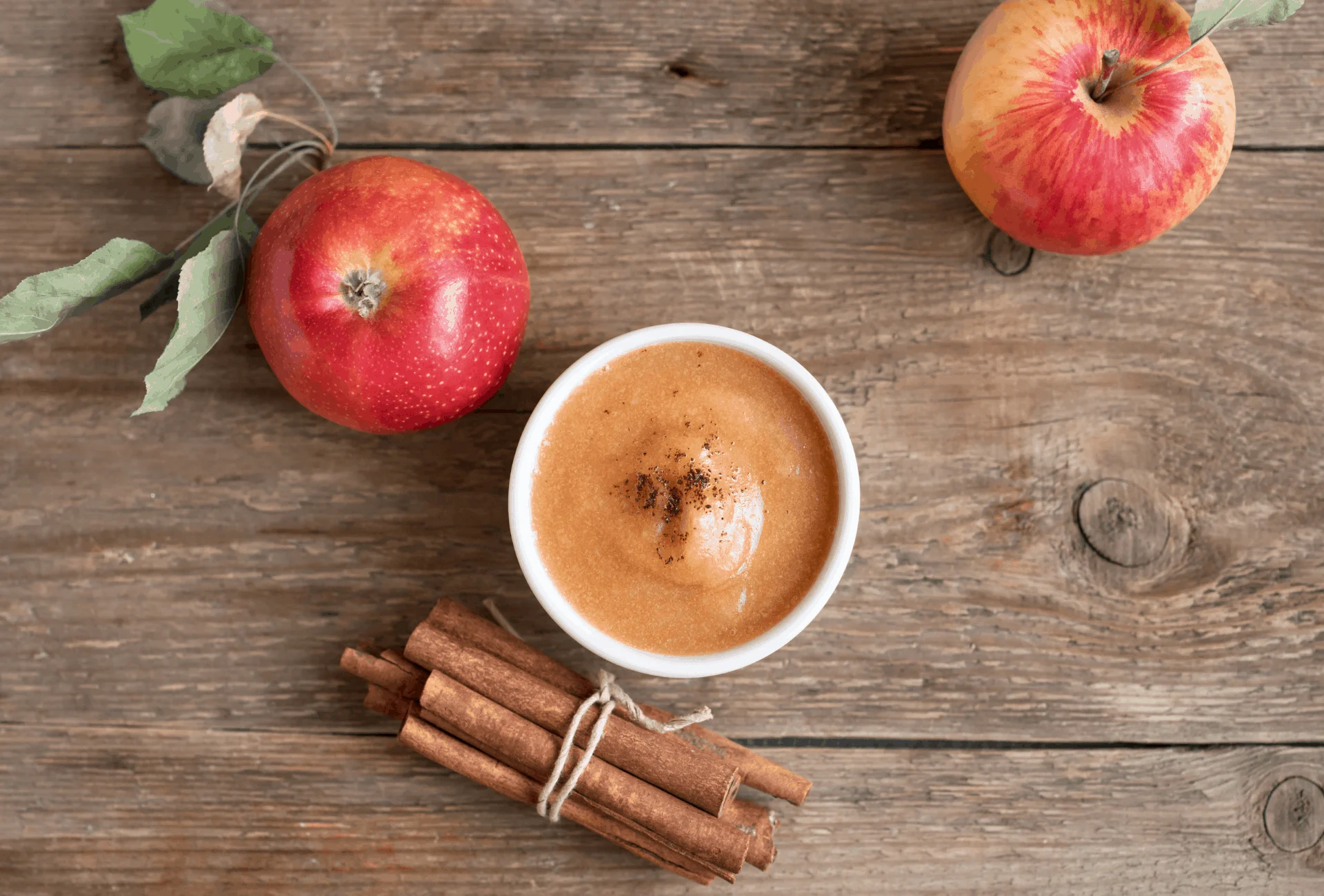Apples are one of the most commonly consumed fruits and since the 18th century, we love to enjoy them in their pureed form, applesauce.
Well, this tasty food doesn’t only look like a treat to us and many dogs have begged to try it.
But can dogs really eat applesauce? Are there any risks or benefits involved? And how much applesauce can I safely feed my dog?
Those questions and more will be answered down below including a recipe to make your own homemade applesauce.
Is Applesauce Good for Dogs?
As applesauce is mainly made from apples, it is safe for dogs to consume to a certain extent.
While applesauce is just a pureed version of apples, most store-bought products contain unhealthy ingredients such as preservatives, sugar, food coloring, and pesticides.
Apples themselves have many beneficial nutrients and can even help fight against major diseases.
But too much of that healing potion could go the other way and you will have to be careful when feeding your dog certain amounts or different flavors.
Benefits of Applesauce for Dogs
Below is a detailed list of many benefits that your dog can obtain from consuming apples or applesauce:
- Low in sodium, fat and calories
- Full of antioxidants that help protect against free-radicals
- Contain lots of calcium and phosphorus for strong and healthy teeth, bones and nails
- High in soluble fiber which is great for digestion (helps prevent constipation and diarrhea) and they may also have prebiotic effects
- Vitamin C can help with degenerative conditions like joint diseases
- Vitamin A for healthy coat and skin
- Can improve memory and heart function
- Promote weight loss (only unprocessed apples)
- Contained pectin which keeps down cholesterol levels
- Reduce the risk of diabetes
One medium apple (6.4 oz) can contain 25 g carbs, 4 g fibre and 95 calories. Keep in mind that this may vary depending on the type of apple you choose.
However, removing the skin will leave you with only half the fibre and a lot less nutrients. But why is the peel so much more nutrient dense?
Antioxidant levels can be 300 times higher in the skin compared to the flesh.

This is essential to protect the fruit from the environment and possible microbes such as bacteria or fungi.
They will also keep the fruit from oxidizing in the air (enzymic browning).
When you cut open an apple you will notice that it turns brown very quickly because there is nothing that protects the injured plant tissue.
How Much Applesauce Can I Feed My Dog?
Just like anything containing fibrous fruits, applesauce should not be eaten regularly and rather as a yummy treat for your dog once in a while.
It can cause digestive issues if consumed in larger quantities.
Applesauce should only constitute 5% of your dog’s diet. It’s better not to feed it every day to reserve it as a special treat for certain occasions.
You can also feed your dog fresh apples cut into slices without the core and seeds which can be a choking hazard as well as poisonous due to the containing amygdalin which is a sugar- and cyanide-based compound.
Apples can be sliced, cut into pieces, and added to your dog’s food or chilled to use it as a cool treat in the summer.
What I like to do is making my own apple chews. These are super simple and only require apples.
You will need to cut them into thin slices, arrange them on a baking sheet and bake them at 210 °F (100 °C) for 2 hours (flipping halfway through).
Can Dogs Eat Cinnamon Applesauce?
In general, dogs can consume applesauce with cinnamon as both are non-toxic to them, however most store-bought cinnamon applesauce options contain sugar and other additives besides the cinnamon.
Cinnamon is a very healthy spice with many benefits for dogs and humans. It’s anti-inflammatory properties can help with joint pain, arthritis and swelling.
It can also regulate your dog’s blood sugar and insulin levels by slowing down the absorption of sugar.
A serving of 1/8 teaspoon for every 15 pounds of body weight should be sufficient and will add a nice touch to the applesauce.
Make sure to thoroughly stir the cinnamon into the applesauce as the powder can severely irritate their lungs and mouth.
Also, avoid feeding your dog cinnamon sticks as they could lead to digestive issues.
Applesauce for Diarrhea in Dogs
Applesauce is part of the BRAT diet which is a common home remedy to treat diarrhea in dogs. It consists of bananas, rice, apples (or plain applesauce), and toast.
As continuing feeding your dog his normal food could further irritate his digestive tract, opting for something more gentle will give him a chance to heal.
More severe diarrhea should be treated with a 24-hour no-food diet.
Make sure to choose the plainest applesauce you can find that has zero additives and is preferably organic. The rice should also be plain and the toast should have nothing on it.
Applesauce is also great for constipation as fibrous fruits stimulate more frequent bowl movement.

Can Dogs Eat Strawberry Applesauce?
Adding strawberries to your dog’s applesauce is an awesome way to incorporate even more fresh and healthy fruits to his diet.
Strawberries are also very similar to apples benefit wise.
They are low in calories, high in fibre, antioxidants and vitamin C meaning they are strengthening the immune system and help managing your dog’s weight.
But most strawberries flavored applesauces are sweetened, that’s why we recommend making your own version using the recipe below.
In the end, you can just mix in blended strawberries.
Other safe fruits and berries you can add to homemade applesauce are blueberries, mango, pineapple, peach and raspberries.
Can Dogs Eat Mott’s Applesauce?
To see if you could share a spoon of Mott’s applesauce with your dog, a closer look at the ingredients list will be necessary.
Mott’s applesauce contains apples, high fructose corn syrup, water, and ascorbic acid (Vitamin C).
Now, what does this really mean? High-fructose corn syrup is an artificial sugar made from corn syrup.
Consuming this ingredient may come with several health risks such as obesity, diabetes, and fatty liver disease.
HFCS has also been linked to increased inflammation that could lead to health issues like cancer and heart disease.
In larger quantities, ascorbic acid cannot be absorbed by dogs or humans which could lead to diarrhea.
If you want to supplement your dog’s diet with vitamin C, choose mineral ascorbates which can be easily assimilated by his digestive system.
We would not recommend feeding your dog Mott’s applesauce just because it contains unnecessary sugar and most healthy dogs won’t need extra vitamin C in their diet.
Can Puppies Have Applesauce?
Puppies can have applesauce however their digestive tract is not fully developed yet and can’t handle the usual adult amount.
Be really cautious and only feed your puppy tiny amounts just as a special treat.
Apples do contain vitamin C which is important for normal puppy growth. Nevertheless, they don’t need applesauce to become healthy and strong adult dogs.
Whenever you are feeding your dog or puppy something new, watch their physical reaction.
Do they respond with diarrhea, vomiting or bellyaches? Do you notice your puppy drinking excessive amounts of water after consuming applesauce?
Those are signs that you have either fed them too much too fast or that they simply cannot digest it properly.
Difficulty breathing or hives could be an indication that that your dog is suffering from an allergic reaction. All apple consumption should be stopped then.
Homemade Applesauce for Dogs
Preparing your dog and yourself some homemade applesauce is the safest and healthiest option and it’s incredibly easy!
You will just need 3 lbs apples (choose any kind you like and you can even mix them up), 1/2 cup water, and 1/2 teaspoon ground cinnamon.
Simply slice up the apples, core them carefully (make sure that there are 0 seeds left) and put them together with the rest of the ingredients in a large pot.
Cook them over medium heat for about 20 minutes.
To puree them, just use a blender and adjust the chunkiness of the applesauce to your liking.
Instead of cinnamon, you can also choose 1 teaspoon of honey which is also safe for dogs.
Best Unsweetened Applesauce
There are various brands online and in stores that sell different versions of applesauce like GoGo squeeZ, Mott’s, and Santa Cruz and luckily a lot of them are unsweetened.
We have chosen the Eden organic applesauce to be our top pick.
It is not only unsweetened and organic but has also nothing else added to it, just apples.
If this is not available online or you cannot find it in your store, Mott’s unsweetened applesauce is also an alternative.
Let me know in the comments down below how you like preparing your applesauce and if your dog likes tasting it.
Related Posts:
- Can dogs eat apples?
- Can dogs eat eggs?
- Can dogs eat rice?
- Can dogs eat oranges?
- Can dogs eat sweet potato skin?
- Can dogs eat jello?
- Can dogs eat chicken?

Ruby
Tuesday 13th of October 2020
A very informative guide! I will try incorporating baked apples or applesauces into my dogs treats!
Danielle
Tuesday 13th of October 2020
Thanks for the kind words, Ruby! Baking for our furry friends is always awesome :)
Bhavik Chhuchha
Monday 12th of October 2020
In-depth and nicely explained. Thanks for sharing Danielle :)